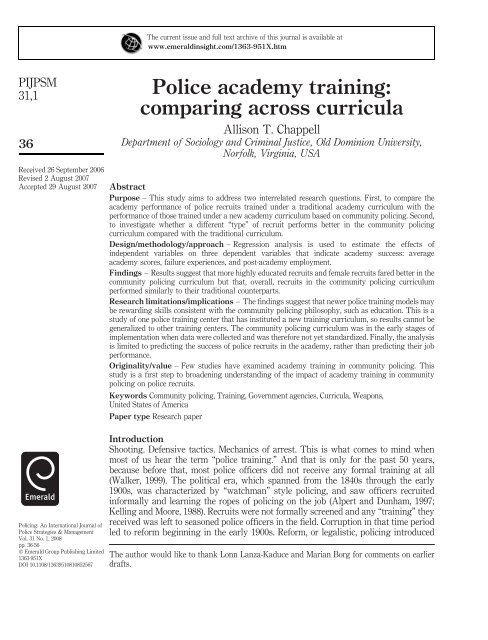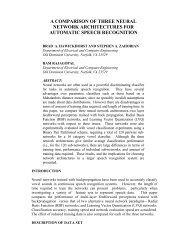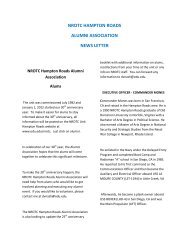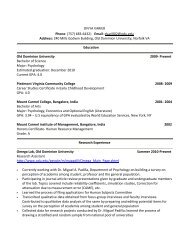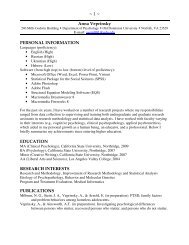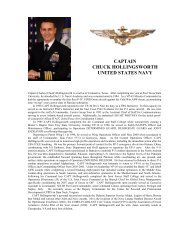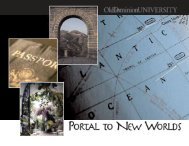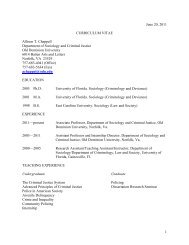Police academy training: comparing across curricula - Emerald
Police academy training: comparing across curricula - Emerald
Police academy training: comparing across curricula - Emerald
Create successful ePaper yourself
Turn your PDF publications into a flip-book with our unique Google optimized e-Paper software.
The current issue and full text archive of this journal is available at<br />
www.emeraldinsight.com/1363-951X.htm<br />
PIJPSM<br />
31,1<br />
36<br />
<strong>Police</strong> <strong>academy</strong> <strong>training</strong>:<br />
<strong>comparing</strong> <strong>across</strong> <strong>curricula</strong><br />
Allison T. Chappell<br />
Department of Sociology and Criminal Justice, Old Dominion University,<br />
Norfolk, Virginia, USA<br />
Received 26 September 2006<br />
Revised 2 August 2007<br />
Accepted 29 August 2007<br />
Policing: An International Journal of<br />
<strong>Police</strong> Strategies & Management<br />
Vol. 31 No. 1, 2008<br />
pp. 36-56<br />
q <strong>Emerald</strong> Group Publishing Limited<br />
1363-951X<br />
DOI 10.1108/13639510810852567<br />
Abstract<br />
Purpose – This study aims to address two interrelated research questions. First, to compare the<br />
<strong>academy</strong> performance of police recruits trained under a traditional <strong>academy</strong> curriculum with the<br />
performance of those trained under a new <strong>academy</strong> curriculum based on community policing. Second,<br />
to investigate whether a different “type” of recruit performs better in the community policing<br />
curriculum compared with the traditional curriculum.<br />
Design/methodology/approach – Regression analysis is used to estimate the effects of<br />
independent variables on three dependent variables that indicate <strong>academy</strong> success: average<br />
<strong>academy</strong> scores, failure experiences, and post-<strong>academy</strong> employment.<br />
Findings – Results suggest that more highly educated recruits and female recruits fared better in the<br />
community policing curriculum but that, overall, recruits in the community policing curriculum<br />
performed similarly to their traditional counterparts.<br />
Research limitations/implications – The findings suggest that newer police <strong>training</strong> models may<br />
be rewarding skills consistent with the community policing philosophy, such as education. This is a<br />
study of one police <strong>training</strong> center that has instituted a new <strong>training</strong> curriculum, so results cannot be<br />
generalized to other <strong>training</strong> centers. The community policing curriculum was in the early stages of<br />
implementation when data were collected and was therefore not yet standardized. Finally, the analysis<br />
is limited to predicting the success of police recruits in the <strong>academy</strong>, rather than predicting their job<br />
performance.<br />
Originality/value – Few studies have examined <strong>academy</strong> <strong>training</strong> in community policing. This<br />
study is a first step to broadening understanding of the impact of <strong>academy</strong> <strong>training</strong> in community<br />
policing on police recruits.<br />
Keywords Community policing, Training, Government agencies, Curricula, Weapons,<br />
United States of America<br />
Paper type Research paper<br />
Introduction<br />
Shooting. Defensive tactics. Mechanics of arrest. This is what comes to mind when<br />
most of us hear the term “police <strong>training</strong>.” And that is only for the past 50 years,<br />
because before that, most police officers did not receive any formal <strong>training</strong> at all<br />
(Walker, 1999). The political era, which spanned from the 1840s through the early<br />
1900s, was characterized by “watchman” style policing, and saw officers recruited<br />
informally and learning the ropes of policing on the job (Alpert and Dunham, 1997;<br />
Kelling and Moore, 1988). Recruits were not formally screened and any “<strong>training</strong>” they<br />
received was left to seasoned police officers in the field. Corruption in that time period<br />
led to reform beginning in the early 1900s. Reform, or legalistic, policing introduced<br />
The author would like to thank Lonn Lanza-Kaduce and Marian Borg for comments on earlier<br />
drafts.
asic <strong>training</strong> of police officers (Alpert and Dunham, 1997; Kelling and Moore, 1988).<br />
However, <strong>training</strong> varied widely by state, agency, and budget, and most recruits were<br />
still insufficiently prepared for police work (Alpert and Dunham, 1997).<br />
We have come a long way since then, and we are now well into the community<br />
policing era (Kelling and Moore, 1988). The new era highlights the importance of<br />
cultural diversity, communications, crime prevention, and problem-solving. Indeed,<br />
<strong>training</strong> is one of the key elements necessary for community policing to reach its full<br />
potential (King and Lab, 2000; Senna and Siegel, 2002; Zhao and Thurman, 1995).<br />
“Community-oriented policing” (or COPS) is currently touted by academicians and<br />
practitioners as the answer to crime and disorder problems and police-community<br />
conflict (Rosenbaum and Lurigio, 1994). The federal government has also been<br />
supportive, providing financial incentives to agencies who agree to participate in<br />
community policing activities. For example, the Office of Community Oriented Policing<br />
Services, a branch of the Department of Justice, provided money for over 100,000 new<br />
officers for COPS in the 1990s (Bureau of Justice Statistics, 2000). To date, COPS has<br />
been a well-funded government program (Lab, 2004).<br />
The definition of COPS has been the subject of much scholarly debate. Agencies,<br />
practitioners, and researchers tend to define it differently, though most advanced<br />
definitions contain similar principles, including problem solving, community<br />
involvement, and organizational decentralization (Chappell and Lanza-Kaduce, 2004).<br />
Quality of life and crime prevention are also emphasized (Community Policing<br />
Consortium, 2006). Whereas traditional policing was reactive and incident-based,<br />
COPS is proactive and seeks to solve problems that generate repeat calls for service.<br />
Generally, the COPS philosophy posits that officers work with neighborhood residents<br />
to define problems from the bottom up and then work together to solve those problems,<br />
rather than respond to calls for service as separate incidents. Trojanowicz and<br />
Bucqueroux (1990) offer the following definition of community policing:<br />
Community policing is a new philosophy of policing, based on the concept that police officers<br />
and private citizens working together in creative ways can help solve contemporary<br />
community problems related to crime, social and physical disorder, and neighborhood decay.<br />
The philosophy is predicated on the belief that achieving these goals requires that police<br />
departments develop new relationships with law-abiding people in the community, allowing<br />
them a greater voice in setting local police priorities and involving them in efforts to improve<br />
the overall quality of life in their neighborhoods. It shifts the focus of police work from<br />
handling random calls to solving community problems (Trojanowicz and Bucqueroux, 1990,<br />
p. 5).<br />
Though community-oriented policing (COPS) has sparked research and debate,<br />
<strong>training</strong> of police officers within such a framework has yet to receive much attention<br />
(or resources). <strong>Police</strong> <strong>training</strong> reflecting a community-oriented approach is a relatively<br />
new phenomenon, although COPS itself has existed in theory and practice since the<br />
1980s (Trojanowicz and Bucqueroux, 1990). Historically, <strong>training</strong> of police officers has<br />
been slow to keep up with policing practice, and <strong>training</strong> in COPS has been no<br />
exception (Bradford and Pynes, 1999).<br />
The roles and responsibilities of police officers differ under COPS, and most existing<br />
<strong>training</strong> programs insufficiently address the underlying causes of crime and disorder,<br />
coalition-building, and crime prevention (King and Lab, 2000). Traditional <strong>training</strong><br />
prepared officers for a narrow focus on law-enforcement duties, rather than the more<br />
<strong>Police</strong> <strong>academy</strong><br />
<strong>training</strong><br />
37
PIJPSM<br />
31,1<br />
38<br />
generalist approach that community policing entails. Traditional <strong>training</strong> focused on<br />
physical activities, such as firearms <strong>training</strong>, physical <strong>training</strong>, defensive tactics, and<br />
driving. Traditional <strong>training</strong> also included some knowledge areas such as law, arrest<br />
procedures, traffic enforcement, and officer safety. Neglected were areas such as<br />
communications, diversity, problem solving, and police-community relations.<br />
Finally, some states such as Florida, Illinois and Michigan, have begun to address<br />
the importance of <strong>training</strong> in COPS in an effort to make COPS a success (Dantzker et al.,<br />
1995; Trojanowicz and Belknap, 1986). Further, they have begun to implement basic<br />
recruit <strong>training</strong> programs reflecting a COPS and/or problem solving orientation. Still,<br />
the few COPS <strong>training</strong> programs that do exist tend to be in the early stages and may be<br />
struggling with implementation. Their impact has yet to be evaluated (Chappell et al.,<br />
2005; Dantzker et al., 1995; Trojanowicz and Belknap, 1986).<br />
This research seeks to address a gap in the literature by analyzing police recruit<br />
<strong>training</strong> under a COPS philosophy by <strong>comparing</strong> it to the former traditional <strong>training</strong><br />
curriculum used in Florida. It investigates how COPS and problem solving are being<br />
integrated into basic recruit <strong>training</strong> and the extent to which it is producing differences<br />
in recruit <strong>academy</strong> performance. Specifically, the study will address the following<br />
questions in depth:<br />
RQ1. To what extent are quantifiable differences in <strong>academy</strong> recruit performance<br />
predicted by the community policing curriculum?<br />
RQ2. Does a different “type” of recruit perform better under the community policing<br />
curriculum compared to the traditional curriculum?<br />
What makes this study unique is the timing: As the author began research at the police<br />
<strong>academy</strong>, the traditional curriculum was undergoing a complete restructuring to reflect<br />
an innovative problem solving, community-oriented focus in what became known as<br />
the Curriculum Maintenance System (CMS) curriculum. The research spanned both<br />
<strong>curricula</strong> and thus allows comparison of the two <strong>training</strong> approaches.<br />
Literature review<br />
<strong>Police</strong> <strong>training</strong><br />
<strong>Police</strong> <strong>training</strong> in the reform era focused primarily on the technical and mechanical<br />
aspects of acquiring skills, such as marksmanship, driving skills, and defensive tactics<br />
(Alpert and Dunham, 1997), while neglecting “softer” subjects like communication and<br />
problem solving (Birzer, 1999). Many academies, or police <strong>training</strong> centers, continue to<br />
train this way today. Recruits spend 90 percent of their <strong>training</strong> time on firearms,<br />
driving, first aid, self-defense and other use-of-force tactics even though only 10 percent<br />
of their job duties will put them in positions where they need to use these skills<br />
(Germann, 1969; Mayhall et al., 1995). Some jurisdictions base their basic recruit<br />
<strong>training</strong> on a Job Task Analysis (JTA) in order to ensure that <strong>training</strong> reflects what is<br />
done on the job. However, JTA often focuses on what has traditionally been done on the<br />
job and not necessarily what needs to be learned to do the job better or to prepare new<br />
officers for community policing.<br />
We are still in the transition from the reform era to the community era. Though<br />
community policing has existed as a philosophy for over 30 years, the development of<br />
particular operational practices associated with the philosophy has taken longer to<br />
develop. Training, in particular, has been slow to adapt to community policing (or
COPS). The transition is especially difficult given the conflicting values and practices<br />
between traditional (or reform) policing and current policing. For example, while<br />
traditional policing emphasizes strict enforcement of the law, COPS emphasizes<br />
building relationships between police and community/neighborhood residents in order<br />
to work together to prevent crime and solve problems (Trojanowicz and Bucqueroux,<br />
1990). The emphasis is on resolving recurring problems rather than intervening in<br />
single incidents. Other attempts to improve or reform the police have often relied upon<br />
new or improved <strong>training</strong> (Buerger, 1998; Fogelson, 1977).<br />
The purpose of community policing <strong>training</strong> is to “provide officers with a level of<br />
understanding that will allow them to effectively employ problem solving and<br />
community engagement techniques in their daily work” (Peak and Glensor, 1999).<br />
Further, newer <strong>training</strong> <strong>curricula</strong> aim to reflect what is realistically done on the job (i.e.<br />
order maintenance and service). Because the recruit <strong>academy</strong> is such an important part<br />
of occupational socialization for police officers, it is necessary that <strong>training</strong> centers<br />
teach the philosophy of COPS during recruit <strong>training</strong> (Peak, 1993). Without proper<br />
<strong>training</strong>, officers will be less likely to understand the philosophy of COPS and/or how<br />
to translate the philosophy into effective practice (King and Lab, 2000).<br />
Few researchers have studied <strong>academy</strong> <strong>training</strong> and specifically looked at its<br />
coverage of problem solving and community policing, but the ones that have<br />
invariably reported a lack of sufficient coverage (Bradford and Pynes, 1999; Marion,<br />
1998). For example, Bradford and Pynes (1999) examined syllabi and <strong>curricula</strong> from 22<br />
police academies and concluded that less than 3 percent of basic <strong>training</strong> <strong>academy</strong> time<br />
is spent on cognitive and decision-making areas, such as scenarios, communications,<br />
reasoning, and application. They found that more than 90 percent of <strong>academy</strong> time was<br />
spent on task-oriented <strong>training</strong> associated with the reactive nature of traditional<br />
policing (e.g. defensive tactics, driving, mechanics of arrest).<br />
Importantly, the shift in policing toward community relations, problem solving, and<br />
COPS heightens the need for improved knowledge bases and additional skills but does<br />
not diminish the need for traditional skills (Bradford and Pynes, 1999; Buerger et al.,<br />
1999). For example, recruits would be ill-served if <strong>training</strong> in officer safety were short<br />
changed. COPS <strong>training</strong> augments the curriculum by including topics on human<br />
diversity, special populations (such as the elderly and mentally ill), “assessing<br />
situations,” public speaking, ethics and integrity, proactive or “coactive” problem<br />
solving, crime prevention, stress management, domestic violence, and community<br />
building (see Palmiotto et al., 2000). The skills necessary for COPS will not become<br />
second-nature if comprehensive <strong>training</strong> in the theories and methods of<br />
community-oriented policing are not provided. This means that recruits must<br />
understand the meanings and values associated with community-oriented policing (e.g.<br />
building trust within the neighborhood) as well as the skills needed to conduct<br />
community-oriented policing (e.g. SARA type problem-solving) (Eck and Spelman,<br />
1987).<br />
One challenge facing <strong>training</strong> concerns the incorporation of alternative learning<br />
models more suited for adults (Birzer, 2003, Glenn et al., 2003). Traditional <strong>training</strong> in<br />
subject areas like law and communications builds on the pedagogical approach used<br />
when teaching children. The pedagogy is teacher-centered and structured, and it relies<br />
heavily on a lecture format (often referred to by trainees as “talking heads”). This style<br />
emphasizes mastery, obedience and discipline, and supports the narrow focus on law<br />
<strong>Police</strong> <strong>academy</strong><br />
<strong>training</strong><br />
39
PIJPSM<br />
31,1<br />
40<br />
enforcement that characterizes traditional policing (Birzer and Tannehill, 2001). <strong>Police</strong><br />
recruits are adults and are likely to benefit from interactive adult learning techniques,<br />
such as andragogy (Birzer, 2003; Glenn et al., 2003). Andragogy is a<br />
self-directed/learner-center approach that promotes the teacher as the catalyst of<br />
education (Knowles, 1990).<br />
Therefore, <strong>training</strong> in COPS requires a substantive change in <strong>curricula</strong> as well as a<br />
change in delivery. Promoters of innovative <strong>training</strong> programs recognize that police<br />
recruits not only need to learn the traditional skills of policing (e.g. officer safety,<br />
mechanics of arrest, marksmanship), but they need a comparable amount of <strong>training</strong> in<br />
such subjects as problem solving, diversity and communications. Further, they<br />
recognize that police recruits are adults and interactive learning techniques are more<br />
effective than teacher-centered approaches that have historically been used in police<br />
academies (Glenn et al., 2003). The current study compares the <strong>academy</strong> performance<br />
of police recruits in a <strong>training</strong> program based on traditional policing to the performance<br />
of recruits in the new CMS curriculum, which is based on community policing, problem<br />
solving and adult learning.<br />
Current study<br />
This study addresses two interrelated research questions:<br />
(1) To what extent are quantifiable differences in recruit performance predicted by<br />
the CMS curriculum?<br />
(2) Does a different type of recruit excel in the CMS curriculum compared to the<br />
traditional curriculum?<br />
In other words, is the CMS curriculum rewarding recruits differently compared to the<br />
traditional curriculum? In order to address these questions, the current study examines<br />
background characteristics, demographics, and <strong>academy</strong> performance (including<br />
average examination scores, failure experiences, and job placement) for police recruits<br />
who entered the basic recruit <strong>academy</strong> between 1998 and 2003. Herein, the research<br />
setting and sample are described.<br />
Setting<br />
The police <strong>academy</strong> is a regional, non-residential <strong>training</strong> center that provides recruit<br />
and in-service <strong>training</strong> for police officers, corrections personnel, and Emergency<br />
Medical Technicians (EMT). It includes a firing range, an agility course, physical<br />
<strong>training</strong> areas, a vehicle driving range, and several permanent buildings and<br />
temporary classrooms. Each basic recruit class (BRC) is administered by a class<br />
coordinator who sets the schedule and is responsible for overseeing recruit conduct and<br />
other issues. The <strong>training</strong> center employs many full-time instructors as well as<br />
“adjunct” instructors from local agencies (e.g. police and sheriff’s agencies, District<br />
Attorney’s Office) who teach courses in their specialty area.<br />
The Florida Department of Law Enforcement (FDLE) Standards and Training<br />
Commission completely redesigned its basic recruit curriculum and created a new<br />
<strong>training</strong> program reflecting a community-oriented, problem solving approach called<br />
the Curriculum Maintenance System (CMS). The CMS curriculum went into pilot form<br />
in May 2002 and final form on July 1, 2004. As of July 1, 2004, it became mandated by<br />
the State of Florida as the required <strong>training</strong> curriculum for all police recruits, but for
the classes studied for this research, it was closely monitored and updated by Florida<br />
Department of Law Enforcement (via close circuit television and on-site evaluators).<br />
Other feedback mechanisms were utilized as well, such as instructor and participant<br />
(recruit) surveys (see McLaughlin and Donahue, 1995). In other words, during the<br />
study period, the curriculum was not yet in standard format.<br />
According to FDLE, changes include:<br />
.<br />
redesign of the basic recruit curriculum based upon a problem solving model;<br />
.<br />
incorporation of scenarios as the basis for all <strong>training</strong>;<br />
<strong>Police</strong> <strong>academy</strong><br />
<strong>training</strong><br />
41<br />
.<br />
interactive CD-ROMs featuring a number of the problem solving scenarios; and<br />
.<br />
complete design, on paper, of a virtual community and surrounding environment<br />
for use within the scenario-based <strong>training</strong>.<br />
According to FDLE, the CMS curriculum is different from the traditional curriculum in<br />
the following ways:<br />
.<br />
it focuses on application of learning rather than memorization;<br />
.<br />
it utilizes a problem-solving model (SECURE) throughout the <strong>academy</strong> (see<br />
below);<br />
.<br />
it uses scenarios as the basis for learning;<br />
.<br />
it includes all-new lesson plans, support materials, in-class examinations, and<br />
student workbooks; and<br />
.<br />
the new state certification exam (to be taken after graduation from the <strong>academy</strong>)<br />
includes both application and knowledge questions.<br />
The CMS curriculum uses the SECURE model, which is similar to SARA<br />
(Scan-Analyze-Respond-Assess), but adds and changes several elements. SECURE<br />
represents Safety, Ethics, Community, Understanding, Response, and Evaluation. It<br />
combines a first response model to resolve short-term incidents and a long-term model<br />
to solve recurring problems. Additionally, CMS “threads” themes throughout the<br />
curriculum. That is, instead of covering a single topic and completing it in one course<br />
or module (e.g. diversity), it revisits certain important themes in each and every<br />
module. Such themes include problem solving/SECURE, diversity, community<br />
policing, and officer safety. For example, a module on “traffic stops” would presumable<br />
include lessons about diversity and officer safety.<br />
The CMS curriculum is considered a “living” document, so instructors are<br />
encouraged to submit their feedback in order to update and improve the curriculum.<br />
This means that each class may be somewhat different because the curriculum<br />
evolves[1]. The police <strong>academy</strong> studied for this research was one of the first regional<br />
<strong>training</strong> facilities in Florida to adopt the CMS curriculum.<br />
During data collection, the author spent over 100 hours observing <strong>academy</strong><br />
instruction under both traditional and CMS <strong>curricula</strong>. The CMS curriculum was more<br />
interactive compared to the traditional curriculum. Many of the sessions began with a<br />
scenario (e.g. recruits got into groups and worked through a scenario from their text)<br />
and followed with a lecture that focused on the lessons learned from the scenario. The<br />
SECURE problem solving model was incorporated into the majority of the classroom<br />
lessons in an interactive format. For example, the instructor would ask recruits to
PIJPSM<br />
31,1<br />
42<br />
brainstorm about ethical (i.e. the “E” in SECURE) considerations in investigating a<br />
potential DUI (Driving Under the Influence) scenario. Some of the physical exercises,<br />
such as defensive tactics, appeared to change little with the change in curriculum.<br />
Overall, the CMS curriculum was more structured than the traditional curriculum and<br />
there was less “down” time. This could be attributed to the increased accountability of<br />
the staff (e.g. video cameras, observers) while the curriculum was in pilot form.<br />
Data<br />
This research examines official data from recruitment and selection at the police<br />
<strong>academy</strong> (e.g. age, gender, race, education, military experience), as well as measures of<br />
<strong>academy</strong> performance (examination scores, failure experiences, and post-graduation<br />
employment status). The <strong>academy</strong> data were collected under two <strong>curricula</strong>: a<br />
traditional curriculum and the updated CMS curriculum which threaded COPS,<br />
problem solving, and scenarios throughout all <strong>training</strong> units.<br />
Access was obtained to official data on a sample of 300 <strong>academy</strong> recruits, 155 of<br />
whom went through the traditional curriculum and 145 of whom went through the<br />
CMS curriculum. The sample includes all persons who were cleared to enter the Basic<br />
Recruit Curriculum (BRC) from 1998 through 2004. It includes classes 68, 69, 71-75<br />
from the traditional curriculum and 76-79, 81-83 from the CMS curriculum[2].<br />
Methods<br />
The quantitative data on 300 <strong>academy</strong> police recruits address two interrelated research<br />
goals. The first goal is to examine the impact of various background and demographic<br />
characteristics, including CMS <strong>training</strong>, on recruit performance in the <strong>academy</strong>. This<br />
part of the analysis develops models that incorporate variables identified in previous<br />
literature that significantly influence policing performance. The models also include a<br />
variable that distinguishes between recruits taught under the CMS curriculum and the<br />
traditional curriculum. The second goal is to assess whether specific background<br />
characteristics better predict <strong>academy</strong> performance among CMS recruits compared to<br />
traditional recruits.<br />
Dependent variables<br />
The term “<strong>academy</strong> performance” is used to refer to recruits’ success in the <strong>academy</strong><br />
and likelihood of employment by a law enforcement/police agency. Three variables are<br />
used to measure recruits’ <strong>academy</strong> performance: average <strong>academy</strong> examination score<br />
(average score <strong>across</strong> all examinations), failure experience, and post-<strong>academy</strong><br />
employment.<br />
Average <strong>academy</strong> score for each recruit is measured with an ordinal variable thus<br />
OLS will be used[3]. The scale is as follows: 1 refers to an average score of 80 percent or<br />
less, 2 refers to a score of 80.01 percent to 84.9 percent, 3 to a score of 85 percent to 89.9<br />
percent, 4 to a score of 90 percent to 94.9 percent, and 5 to a score of 95 percent through<br />
100 percent[4].<br />
Failure experience is operationalized as a recruit who failed one module or unit, or a<br />
recruit who failed out of the <strong>academy</strong>. The original variable distinguished between<br />
those who failed any individual module during <strong>training</strong> and those who were dismissed<br />
from the <strong>academy</strong>, but due to the limited number of failures, it was recoded into a<br />
dichotomous variable. It is coded (0 ‘no’, 1 ‘yes’) and represents recruits who showed
significant problems completing their <strong>academy</strong> class. Logistic regression is used for<br />
this model (McClendon, 2002).<br />
Recruits’ employment status is based on the current information available in the<br />
<strong>academy</strong>’s database when data were collected (July 2004). It includes recruits who were<br />
“sponsored” (hired by law enforcement/police agencies prior to commencement of the<br />
<strong>academy</strong>), those who were hired during <strong>academy</strong> <strong>training</strong>, and those who were hired<br />
upon and immediately after graduation from the <strong>academy</strong>. It is possible (and probable)<br />
that graduates of the <strong>academy</strong> who were not employed immediately upon graduation<br />
found employment later on and that is not accurately reflected in these data.<br />
Employment is a dichotomous variable coded ‘0’ for unemployed and ‘1’ for employed.<br />
Logistic regression is used to evaluate differences in employment likelihood between<br />
graduates of the CMS curriculum and the traditional curriculum.<br />
<strong>Police</strong> <strong>academy</strong><br />
<strong>training</strong><br />
43<br />
Independent variables<br />
Previous literature suggests a number of personal characteristics that may affect<br />
policing performance. Though most of the studies do not specify <strong>academy</strong> or <strong>training</strong><br />
performance specifically, they are relevant to becoming a successful COPS officer.<br />
Age. There is no research on the relationship between age and police <strong>training</strong>.<br />
However, some police departments are raising their age requirements based on the<br />
intuitive notion that older applicants will be more mature, have more life experience,<br />
and therefore make better officers (see Lanza-Kaduce and Greenleaf, 2000). Another<br />
reason for hiring older officers is that it gives the agency a longer work history to<br />
evaluate (Decker and Huckabee, 2002). As recruits get older, they become more<br />
responsible and possibly better police officers. Interestingly, Skogan and Hartnett<br />
found that older officers are more supportive of community policing (Skogan and<br />
Hartnett, 1997). Age is a continuous variable.<br />
Race and ethnicity. By 1997, racial and ethnic minorities made up about 22 percent<br />
of full-time sworn officers in local police departments (Bureau of Justice Statistics,<br />
2000). Some large cities now have police forces that represent the racial composition of<br />
their population. However, the National Academy of Sciences has concluded that “there<br />
is no credible evidence that officers of different racial or ethnic backgrounds perform<br />
differently during interactions with citizens simply because of race or ethnicity”<br />
(Skogan and Frydl, 2004). African American officers are more likely to support<br />
innovation and change, such as community policing (Skogan and Hartnett, 1997). Part<br />
of community policing is having a police force that represents the community, thus<br />
racial minorities may be more likely to thrive in the COPS environment. Race is coded<br />
as ‘1’ if nonwhite (black, Hispanic, Asian, or other) and ‘0’ if white.<br />
Gender. Neiderhoffer (1967) recognized that chauvinism was a major characteristic<br />
of the police culture in the 1960s. Women have historically been considered to be more<br />
suited for staying home with their children than for a dangerous job like policing.<br />
However, women may be more suitable for the tasks required of community police<br />
officers because they are more empathetic. COPS calls for the use of de-escalation<br />
techniques, communication skills and problem solving, which may be skills that<br />
women are better at than men (Langworthy and Travis, 2003). Women now make up<br />
approximately 10 percent of all sworn police officers (Reaves and Goldberg, 2000).<br />
Gender is coded as ‘1’ if male, and ‘0’ if female.
PIJPSM<br />
31,1<br />
44<br />
Military experience. Military experience has been one of the favored characteristics<br />
for police recruits since Sir Robert Peele’s police force (Alpert and Dunham, 1997). It is<br />
thought that because policing is a paramilitary occupation, those who have military<br />
experience are better prepared to deal with the environment. However, given the goals<br />
and nature of community policing, the impact of military experience on police<br />
performance seems less clear-cut. In fact, such experience may actually impede the<br />
development of the types of policing strategies that are at the heart of the community<br />
policing philosophy. Recruits are coded ‘1’ if they are listed as “active duty” or<br />
“reserves” in the military, and ‘0’ otherwise.<br />
Education. An increasing number of police officers have at least some college<br />
education (Senna and Seigel, 2002), which is not surprising considering that higher<br />
education for police officers has been recommended by national commissions since<br />
1931 (Hoover, 1975). Overall, 16 percent of state police agencies require a two- year<br />
college degree and 4 percent require a four-year degree. A total of 9 percent of large<br />
municipal agencies have a degree requirement (Reaves and Goldberg, 2000). <strong>Police</strong><br />
recruits with a college degree are said to be better at verbal and written<br />
communication, make better discretionary decisions, and have greater empathy and<br />
tolerance (Carter and Sapp, 1992). They are also said to exercise better judgment and be<br />
better problem solvers compared to those without college degrees (Worden, 1990).<br />
These are skills important to community policing. Education is coded ‘1’ if the recruit<br />
has an Associate’s degree or more education, and ‘0’ otherwise.<br />
Special position. “Special position” refers to recruits who either held a ranking status<br />
within their recruit class (such as class lieutenant, etc.) or achieved an award for<br />
excellence or most improved (e.g. “high academic award” or “most improved fitness”).<br />
Recruits were given the opportunity to apply for these positions by writing a letter to<br />
the Class Commander explaining their qualifications and motivations for leading the<br />
class (prior to commencement of the <strong>academy</strong>). The Class Commander chose officers<br />
based on this information.<br />
There is no literature pertaining to the link between holding a rank in the <strong>academy</strong><br />
class and policing performance. However, it makes logical sense that those who show<br />
initiative up front (and lead the class) should perform better compared to those who do<br />
not hold these positions. This variable is coded ‘1’ if the recruit held a ranking status<br />
and/or won an award and ‘0’ otherwise.<br />
CMS versus traditional. As stated above, one goal of this study is to analyze<br />
whether a different type of recruit excels in the CMS curriculum compared to the<br />
traditional curriculum. Thus, a variable was constructed to denote which curriculum<br />
the recruit attended. CMS is coded ‘1’ if the recruit attended the CMS curriculum and ‘0’<br />
otherwise. Theoretically, officers who graduated from the CMS curriculum will benefit<br />
in their policing careers because the CMS curriculum reflects current policing practices<br />
and up to date material (though, notably, it is beyond the scope of this analysis to<br />
measure job performance).<br />
A note on interactions<br />
There are theoretical reasons to explore why background characteristics may enhance<br />
or detract from success in the new CMS curriculum. Because some variables may<br />
operate differently under the two <strong>curricula</strong>, separate analyses are conducted for<br />
recruits in the traditional <strong>academy</strong> and recruits in the CMS <strong>academy</strong> in order to show
whether background characteristics are significantly and/or differently related to<br />
performance in one group rather than the other[5].<br />
Results<br />
First, I analyze how recruit characteristics affect <strong>academy</strong> performance among all<br />
recruits. Second, I look at predictors of <strong>academy</strong> performance among CMS and<br />
traditional recruits separately. Results will provide insight as to whether certain<br />
“types” of recruits perform differently under the two different <strong>curricula</strong> and how the<br />
CMS curriculum impacts the relationships between recruit characteristics and<br />
<strong>academy</strong> performance.<br />
<strong>Police</strong> <strong>academy</strong><br />
<strong>training</strong><br />
45<br />
Descriptive statistics<br />
Full sample. The full sample contains 300 recruits from both CMS and traditional<br />
<strong>curricula</strong>. The sample is comprised of 155 recruits from the traditional curriculum and<br />
145 recruits from the CMS curriculum. Approximately 24 percent of the full sample is<br />
nonwhite. Overall, 79 percent are male, while only 8 percent have military experience,<br />
28 percent have an Associate’s or higher degree. Recruits were an average of 26 years<br />
old in the <strong>academy</strong> (median 25, mode 24). A total of 48 percent of them attended the<br />
<strong>academy</strong> based on CMS (see Table I for Descriptive Statistics).<br />
About 48 percent of <strong>academy</strong> recruits found employment by the time they<br />
graduated from the <strong>academy</strong> (or immediately upon graduation). About 18 percent of<br />
those who entered the <strong>academy</strong> failed to complete all of their classes without at least<br />
one failure (and/or they failed out completely; this variable includes those who failed<br />
one or more units or modules and came back in later classes to complete them). Of<br />
<strong>academy</strong> recruits, 29 percent of <strong>academy</strong> recruits in the sample either held a ranking<br />
position in their recruit class and/or received an achievement award for fitness,<br />
firearms, or academics (“special position”).<br />
Split samples. The full sample was split based on <strong>training</strong> mode (CMS versus<br />
traditional) in order to assess whether background characteristics predict <strong>academy</strong><br />
performance under one curriculum better than the other. The background<br />
characteristics and demographics vary slightly in the two samples. A higher<br />
percentage of CMS recruits found employment upon graduation compared to<br />
traditional recruits (51 percent versus 46 percent respectively). Traditional recruits<br />
were more likely to have military experience compared to CMS recruits (10 percent<br />
versus 7 percent respectively), and interestingly, traditional recruits were much more<br />
likely to have an Associate’s degree compared to CMS recruits (32 percent versus 23<br />
percent respectively). Though there is pressure to increase educational requirements<br />
for police officers, there is a “cop crunch,” meaning that many departments are<br />
struggling to find qualified police applicants and therefore have had to lower their<br />
selection criteria (Fridell et al., 2002). Finally, CMS recruits were more likely to hold a<br />
“special position” in their recruit class compared to traditional recruits (34 percent<br />
versus 25 percent respectively).<br />
Multivariate models<br />
Does CMS <strong>training</strong> make a difference? The first goal of the analysis is to identify the<br />
impact of various demographic/background characteristics on measures of recruit
PIJPSM<br />
31,1<br />
46<br />
Table I.<br />
Descriptive statistics of<br />
study variables<br />
Full sample CMS recruits Trad recruits<br />
Mean SD Range Mean SD Range Mean SD Range<br />
Dependent variables n ¼ 300 n ¼ 145 n ¼ 155<br />
Academy score (ordinal) 3.3 0.90 1-5 3.3 0.78 1-5 3.3 1.0 1-5<br />
Failure (1 ¼ yes) 0.18 0.38 0-1 0.19 0.40 0-1 0.17 0.37 0-1<br />
Employment (1 ¼ yes) 0.48 0.50 0-1 0.51 0.50 0-1 0.46 0.50 0-1<br />
Independent variables<br />
CMS (1 ¼ yes) 0.48 0.50 0-1 – – – – – –<br />
Race (1 ¼ non-white) 0.24 0.43 0-1 0.23 0.43 0-1 0.25 0.44 0-1<br />
Gender (1 ¼ male) 0.79 0.40 0-1 0.79 0.41 0-1 0.80 0.40 0-1<br />
Age (continuous) 26.4 5.28 19-46 26.3 5.1 19-45 26.5 5.4 19-46<br />
Education (1 ¼ Assoc. degree) 0.28 0.45 0-1 0.23 0.42 0-1 0.32 0.47 0-1<br />
Military (1 ¼ yes) 0.08 0.28 0-1 0.07 0.25 0-1 0.10 0.29 0-1<br />
Special position (1 ¼ yes) 0.29 0.46 0-1 0.34 0.48 0-1 0.25 0.43 0-1
Academy score Failure Employment<br />
B (SE) Beta B (SE) Exp(B) B (SE) Exp (B)<br />
Race (1 ¼ non-white) 20.22 (0.12) 20.105 ** 0.618 (0.34) 1.86 ** 0.429 (0.29) 1.54 *<br />
Gender (1 ¼ male) 0.146 (0.13) 0.065 20.145 (0.38) 0.865 20.156 (0.30) 0.856<br />
Age (continuous) 20.003 (0.01) 20.015 20.006 (0.03) 0.994 0.071 (0.03) 1.074 **<br />
Education (1 ¼ Assoc. degree) 0.249 (0.11) 0.124 ** 0.263 (0.35) 1.30 0.206 (0.28) 1.23<br />
Military (1 ¼ yes) 0.04 (0.19) 0.012 20.891 (0.78) 0.41 21.20 (0.50) 0.30 **<br />
Special position (1 ¼ yes) 0.525 (0.112) 0.265 ** 20.1.42 (0.47) 0.241 ** 0.395 (0.28) 1.49 *<br />
CMS (1 ¼ yes) 0.031 (0.10) 20.017 0.309 (0.32) 1.36 0.216 (0.25) 1.24<br />
Academy score (ordinal) 0.448 (0.15) 1.57 **<br />
Intercept 3.1 (0.29) ** 21.29 (0.96) 0.28 * 23.6 (0.92) 0.027 **<br />
R-Square 0.11 0.103 0.139<br />
Notes: ** p , 0.05; * p , 0.10; p-values computed for one-tailed significance tests<br />
<strong>Police</strong> <strong>academy</strong><br />
<strong>training</strong><br />
47<br />
Table II.<br />
Regression models<br />
predicting <strong>academy</strong><br />
performance of <strong>academy</strong><br />
recruits (n ¼ 300)
PIJPSM<br />
31,1<br />
48<br />
performance. In particular, the analysis seeks to evaluate whether CMS recruits<br />
perform “better” at the <strong>academy</strong> compared to traditional recruits.<br />
Table II shows results for the full sample of recruits. Looking first at predictors of<br />
average <strong>academy</strong> score, results indicate that white, more educated recruits, and those<br />
who held a special position in their class obtained higher <strong>academy</strong> scores compared to<br />
their counterparts. The strongest predictor among these is special position status.<br />
Significant predictors of failure experience include race and special position.<br />
Nonwhites are more likely to experience failure and those with a special position status<br />
are significantly less likely. Finally, race, age, military experience, special position, and<br />
<strong>academy</strong> score significantly influence the last measure of performance: post<br />
graduation employment status. Nonwhites, older recruits, those without military<br />
experience, those with higher <strong>academy</strong> scores, and those with special position status<br />
are more likely to gain employment by graduation compared to younger, white recruits<br />
with military experience who did not hold a special position in their class.<br />
In general, race was significant in all three models: nonwhites had lower <strong>academy</strong><br />
scores, were more likely to fail, and more likely to gain employment upon graduation.<br />
In light of community policing, agencies are being pressured to hire officers who reflect<br />
the racial makeup of the communities they serve, and this often means hiring more<br />
non-white officers. Therefore, it makes sense that although nonwhite recruits may not<br />
perform as well (in this sample), they were more likely to find employment upon<br />
graduation from the <strong>academy</strong>.<br />
Recruits who held a special position in their <strong>academy</strong> class fared better in terms of<br />
<strong>academy</strong> score, failure experiences, and post graduation employment. This makes<br />
intuitive sense, as recruits who held a special position showed initiative, lead the class,<br />
or showed a significant improvement, either academically or physically, during their<br />
<strong>academy</strong> experience.<br />
Analyzing performance among CMS versus traditional recruits. The second goal of<br />
the analysis is to identify whether a different “type” of recruit performs better under<br />
the two different <strong>curricula</strong>. In particular, the analysis seeks to evaluate how the CMS<br />
curriculum impacts the relationships between recruit characteristics and <strong>academy</strong><br />
performance.<br />
Table III shows results for the CMS recruits while Table IV shows results for the<br />
traditional recruits. They can be compared to see which variables predict success<br />
similarly for both <strong>curricula</strong> and which predict success in only one of them. Looking<br />
first at Table III and predictors of average <strong>academy</strong> score, whites, recruits with at least<br />
an Associate’s degree, and recruits who held a special position in their class obtained<br />
higher <strong>academy</strong> scores compared to their counterparts. The only significant predictor<br />
of failure is special position; recruits who held a special position were less likely to<br />
experience failure. Finally, gender, age, military experience, and <strong>academy</strong> score<br />
influenced the likelihood of post-graduation employment at a police agency. In<br />
particular, older recruits, females, those without military experience, and those who<br />
had higher <strong>academy</strong> scores, were more likely to find employment by the time they<br />
graduated.<br />
Table IV shows the results of the regression analysis for the traditional recruits. In<br />
terms of <strong>academy</strong> score, recruits who held a special position and those with military<br />
experience achieved higher scores. Recruits who held a special position were less likely<br />
to experience failure compared to their counterparts who did not hold a special position
Academy score Failure Employment<br />
B (SE) Beta B (SE) Exp (B) B (SE) Exp (B)<br />
Race (1 ¼ non-white) 20.331 (0.14) 20.180 ** 0.59 (0.49) 1.80 20.159 (0.44) 0.853<br />
Gender (1 ¼ male) 0.175 (0.15) 0.092 20.112 (0.54) 0.894 20.634 (0.46) 0.531 *<br />
Age (continuous) 20.001 (0.012) 20.010 20.064 (0.06) 0.94 0.075 (0.04) 1.08 **<br />
Education (1 ¼ Assoc. degree) 0.461 (0.14) 0.248 ** 0.39 (0.50) 1.48 0.367 (0.44) 1.44<br />
Military (1 ¼ yes) 0.12 (0.24) 0.038 20.558 (1.1) 0.572 21.14 (0.77) 0.32 *<br />
Special position (1 ¼ yes) 0.517 (0.13) 0.315 ** 20.1.29 (0.59) 0.275 ** 0.373 (0.40) 1.45<br />
Academy score (ordinal) – – – – 0.531 (0.27) 1.70 **<br />
Intercept 2.99 0.36 ** 0.40 (1.6) 1.49 23.28 (1.4) 0.038 **<br />
R-Square 0.220 – 0.122 – 0.156 –<br />
Notes: ** p , 0.05; * p , 0.10; p-values computed for one-tailed significance tests<br />
<strong>Police</strong> <strong>academy</strong><br />
<strong>training</strong><br />
49<br />
Table III.<br />
Regression models<br />
predicting <strong>academy</strong><br />
performance of CMS<br />
recruits (n ¼ 145)
PIJPSM<br />
31,1<br />
50<br />
Table IV.<br />
Regression models<br />
predicting <strong>academy</strong><br />
performance of<br />
traditional recruits<br />
(n ¼ 155)<br />
Academy score Failure Employment<br />
B (SE) Beta B (SE) Exp (B) B (SE) Exp (B)<br />
Race (1 ¼ non-white) 20.102 (0.19) 20.044 0.62 (0.49) 1.86 * 0.883 (0.41) 2.42 **<br />
Gender (1 ¼ male) 0.05 (0.21) 0.022 20.346 (0.56) 0.707 0.104 (0.44) 1.11<br />
Age (continuous) 20.001 (0.02) 20.007 0.037 (0.04) 1.04 0.062 (0.03) 1.06 **<br />
Education (1 ¼ Assoc. degree) 0.09 (0.17) 0.041 0.070 (0.49) 1.07 0.13 (0.37) 1.14<br />
Military (1 ¼ yes) 0.01 (0.28) 0.003 * 21.17 (1.1) 0.310 21.26 (0.67) 0.28 **<br />
Special position (1 ¼ yes) 0.566 (0.19) 0.244 ** 20.1.60 (0.78) 0.20 ** 0.595 (0.41) 1.81 *<br />
Academy score (ordinal) – – – – 0.39 (0.19) 1.47 **<br />
Intercept 3.15 0.44 ** 22.2 (1.2) 0.011 ** 23.5 (1.2) 0.03 **<br />
R-Square 0.068 – 0.11 – 0.158 –<br />
Notes: ** p , 0.05; * p , 0.10; p-values computed for one-tailed significance tests
in their <strong>academy</strong> class, but non-whites were more likely to fail. In terms of employment,<br />
race, age, military experience, special position and <strong>academy</strong> score were significant. In<br />
particular, older, nonwhite recruits without military experience who held a special<br />
position and achieved higher <strong>academy</strong> scores had a higher likelihood of finding<br />
employment upon graduation compared to their counterparts.<br />
Again, older recruits fared better in terms of finding a job. Interestingly, recruits<br />
with military experience had higher average <strong>academy</strong> scores but were less likely to<br />
find employment in the sample of traditional recruits. Perhaps the traditional<br />
curriculum was more consistent with military <strong>training</strong> so those with military<br />
experience were more successful academically. Again, those who held a special<br />
position achieved higher <strong>academy</strong> scores, were less likely to fail, and were more likely<br />
to find employment upon graduation. Higher <strong>academy</strong> scores were associated with a<br />
higher likelihood of finding employment.<br />
Age, military experience, and <strong>academy</strong> score had similar effects on <strong>academy</strong><br />
performance <strong>across</strong> both <strong>curricula</strong>. Thus, no interactions were present. On the other<br />
hand, there were a few inconsistencies <strong>across</strong> models. In the CMS curriculum, racial<br />
minorities received lower average <strong>academy</strong> scores than whites, while more educated<br />
recruits earned higher <strong>academy</strong> scores compared to those with less education. This<br />
could indicate that CMS is a more academic environment than the traditional<br />
curriculum. In terms of race, it is possible that well-educated racial minorities are<br />
earning opportunities in higher education and self-selecting out of policing.<br />
Additionally, females are more likely to become employed after graduation from the<br />
CMS curriculum compared to males. This indicates that CMS is rewarding skills<br />
consistent with COPS (i.e. empathy compared to physical prowess).<br />
In the traditional curriculum, racial minorities did not perform as well, but they<br />
were more likely to gain employment. Again, this could be due to the pressure on police<br />
agencies to increase minority representation. Finally, special position was positively<br />
associated with finding employment in the traditional curriculum, but not in the CMS<br />
curriculum.<br />
<strong>Police</strong> <strong>academy</strong><br />
<strong>training</strong><br />
51<br />
Discussion<br />
One purpose of this study was to research whether recruits in the CMS curriculum<br />
performed “better” in the <strong>academy</strong> compared to recruits in the traditional curriculum.<br />
A related goal was to investigate whether the CMS curriculum rewards a different<br />
“type” of recruit compared to the traditional curriculum. According to these analyses,<br />
recruits going through the CMS curriculum did not perform significantly “better” in the<br />
<strong>academy</strong> compared to those in the traditional curriculum, but that CMS may be<br />
rewarding a more educated, empathetic recruit.<br />
In terms of whether certain demographic variables predicted performance in either of<br />
the two <strong>curricula</strong>, the data suggest few consistent, clear-cut patterns. “Special position”<br />
emerged as a significant predictor among most of the models, which makes intuitive<br />
sense, because recruits who hold a special position, by definition, must be motivated<br />
(recall that recruits must either “apply” to be chosen for a special position or they are<br />
selected based on outstanding performance). Race also emerged in some of the models as<br />
a significant predictor of performance. In general, nonwhites did not perform as well<br />
compared to whites, but they had a higher likelihood of finding employment. Older
PIJPSM<br />
31,1<br />
52<br />
recruits and those with higher <strong>academy</strong> scores had better luck finding jobs in all three<br />
models. This indicates that police agencies may value a more mature police officer.<br />
Surprisingly, those with military experience were consistently less likely to gain<br />
employment. A possible explanation for this is that the study only looked at law<br />
enforcement employment, and ex-military personnel have a high employment rate in<br />
the area of corrections (correctional officers also go through basic recruit <strong>training</strong>).<br />
Another possibility is that those with a military status were called to active duty and<br />
therefore did not continue to seek law enforcement employment (especially considering<br />
that the timeframe includes Sept. 11, 2001).<br />
Education was associated with a higher average <strong>academy</strong> score in the full sample<br />
and the CMS sample, but not in the traditional sample. This implies that the CMS<br />
curriculum rewards a more educated recruit compared to the traditional curriculum,<br />
which is in line with the COPS philosophy. According to the literature, more educated<br />
recruits make better decisions and are more sophisticated problem solvers and<br />
communicators, compared to their less-educated counterparts (see Worden, 1990).<br />
In the CMS curriculum, females were more likely to secure employment compared to<br />
males. Women are said to be better at exercising “de-escalation” techniques with<br />
suspects and may exhibit more empathy with victims and witnesses. In other words,<br />
females may be more suited for the skills of a COPS officer than the duties of the<br />
traditional crime-fighting officer (Langworthy and Travis, 2003). This is an important<br />
finding in terms of COPS.<br />
There are several issues that must be considered when assessing the relative<br />
“success” of the CMS curriculum. First, it must be noted that the CMS curriculum was<br />
in pilot form during the study period. Thus, instructors were encouraged to submit<br />
feedback so that the “bugs” could be worked out. The majority of the changes were<br />
editorial (e.g. changing “bad” test questions, experimenting with different approaches<br />
to teaching the new material), but each subsequent class was likely somewhat different<br />
from the one that preceded it. Along those lines, it should be noted that <strong>academy</strong><br />
examinations were changed in the CMS curriculum as well. The new curriculum<br />
included all new material.<br />
Another important consideration involves the well-documented police subculture.<br />
Community policing commentators recognize the police subculture as the single biggest<br />
impediment to the successful implementation of policing reforms. Sociological theory<br />
suggests that although formal <strong>training</strong> is important to behavioral outcomes, the informal<br />
content of the <strong>academy</strong> experience is equally significant (Lundman, 1980). Such<br />
arguments indicate that even with significant changes in the formal curriculum, the<br />
transformation towards a COPS philosophy may not occur if the informal culture among<br />
officers remains static. Similarly, research has shown that the effectiveness of COPS<br />
<strong>training</strong> is largely dependent on the instructor; specifically his or her endorsement of the<br />
COPS philosophy. Academy instructors are often veteran officers – police insiders – who<br />
may have strong internalized definitions about traditional policing, and therefore may<br />
struggle to accept the ideals of COPS (Chappell and Lanza-Kaduce, 2004). Senior officers<br />
who have spent the majority of their policing years practicing traditional policing may be<br />
more comfortable teaching what they know. Research suggests that it is important for<br />
instructors to be “on board” with COPS themselves in order to be successful COPS<br />
trainers (Dantzker et al., 1995). If instructors do not buy into the COPS philosophy, recruits<br />
are unlikely to. This study was unable to account for the “informal” component of the
<strong>training</strong> experience, nor did it measure <strong>academy</strong> instructors’ endorsement of community<br />
policing. Future research should take into account these issues.<br />
Further, police recruit performance was measured by analyzing average <strong>academy</strong><br />
score, failure experiences, and recruit employment. Analyzing such measures does not<br />
indicate whether the CMS curriculum affects the way police officers do their jobs<br />
(arguably a much more important question). The curriculum may affect a recruit’s<br />
performance in the <strong>academy</strong> or his or her likelihood of securing employment, but the<br />
more substantive question is whether it impacts the qualitative nature of his or her<br />
policing style. The answer to this question likely lies several years down the road.<br />
Thus, in future research, it would be ideal to compare recruits from the two <strong>curricula</strong> in<br />
terms of their ability to communicate with residents and solve problems. One way to do<br />
this is through ride alongs with officers.<br />
The value of this study lies in its ability to compare characteristics and preliminary<br />
outcomes of the two <strong>curricula</strong>. It provides insight into the myriad issues associated<br />
with <strong>academy</strong> <strong>training</strong> in community policing. Although CMS recruits are not “more<br />
successful” in the <strong>academy</strong> compared to traditional recruits, the data suggest that<br />
different qualities are emerging as significant in policing, such as education and<br />
empathy. Having more educated and diverse police <strong>academy</strong> graduates will likely have<br />
implications for the job performance of our future police officers. Indeed, this is a step<br />
in the right direction.<br />
<strong>Police</strong> <strong>academy</strong><br />
<strong>training</strong><br />
53<br />
Notes<br />
1. One limitation of the study is that the CMS curriculum is constantly being updated based on<br />
instructor and observer feedback. Thus, the traditional curriculum had long been<br />
standardized, while the CMS curriculum (as of the date of this study), was not yet<br />
standardized.<br />
2. Classes 70 and 80 were designated for correctional officers only and were therefore<br />
eliminated from the analyses.<br />
3. The score was computed into an ordinal variable due to several outliers. The technique, OLS,<br />
is robust (Akers et al., 1979).<br />
4. A total of 23 recruits had missing scores on this variable and mean substitution was used.<br />
The analysis was also run without those with missing values and the results were similar.<br />
These 23 recruits graduated from the <strong>academy</strong>, despite missing data on this variable.<br />
5. An alternative method to performing interactions is to compute interaction terms. In the<br />
research process, I computed several interaction terms as well (e.g. CMS X education and<br />
CMS X race) and they were not significant in the model.<br />
References<br />
Akers, R.L., Krohn, M.D., Lanza-Kaduce, L. and Radosevich, M. (1979), “Social learning and<br />
deviant behavior: a specific test of a general theory”, American Sociological Review, Vol. 44,<br />
pp. 635-55.<br />
Alpert, G.P. and Dunham, R.G. (1997), Policing Urban America, Waveland Press, Lake Zurich, IL.<br />
Birzer, M.L. (1999), “<strong>Police</strong> <strong>training</strong> in the 21st century”, FBI Law Enforcement Bulletin, pp. 16-19.<br />
Birzer, M.L. (2003), “The theory of andragogy applied to police <strong>training</strong>”, Policing:<br />
An International Journal of <strong>Police</strong> Strategies and Management, Vol. 26 No. 1, pp. 29-42.<br />
Birzer, M.L. and Tannehill, R. (2001), “A more effective <strong>training</strong> approach for contemporary<br />
Policing”, <strong>Police</strong> Quarterly, Vol. 4 No. 2, pp. 233-52.
PIJPSM<br />
31,1<br />
54<br />
Bradford, D. and Pynes, J.E. (1999), “<strong>Police</strong> <strong>academy</strong> <strong>training</strong>: why hasn’t it kept up with<br />
practice?”, <strong>Police</strong> Quarterly, Vol. 2 No. 3, pp. 283-301.<br />
Buerger, M.E. (1998), “<strong>Police</strong> <strong>training</strong> as a Pentecost: using tools singularly ill-suited to the<br />
purpose of reform”, <strong>Police</strong> Quarterly, Vol. 1, pp. 27-63.<br />
Buerger, M.E., Petrosino, A.J. and Petrosino, C. (1999), “Extending the police role: implications of<br />
police mediation as a problem-solving tool”, <strong>Police</strong> Quarterly, Vol. 2, pp. 125-49.<br />
Bureau of Justice Statistics (2000), Local <strong>Police</strong> Departments, 1997, Bureau of Justice Statistics,<br />
Washington, DC.<br />
Carter, D.L. and Sapp, A.D. (1992), “College education and policing: coming of age”, FBI Law<br />
Enforcement Bulletin, January, pp. 8-14.<br />
Chappell, A.T. and Lanza-Kaduce, L. (2004), “Integrating sociological research with<br />
community-oriented policing: bridging the gap between academics and practice”,<br />
Journal of Applied Sociology/Sociological Practice, Vol. 21 No. 6, pp. 80-98.<br />
Chappell, A.T., Lanza-Kaduce, L. and Johnston, D. (2005), “<strong>Police</strong> <strong>training</strong>: changes and<br />
challenges”, in Dunham, R.G. and Alpert, G.P. (Eds), Critical Issues in Policing, 5th ed.,<br />
Waveland, Prospect Heights, IL, pp. 71-88.<br />
Community Policing Consortium (2006), About Community Policing, available at: www.<br />
communitypolicing.org/about2.html (accessed April 23, 2006).<br />
Dantzker, G., Lurigio, A., Hartnett, A., Houmes, S., Davidsdottir, S. and Donovan, K. (1995),<br />
“Preparing police officers for community policing: an evaluation of <strong>training</strong> for Chicago’s<br />
alternative policing strategy”, <strong>Police</strong> Studies, Vol. 18 No. 1, pp. 745-70.<br />
Decker, L.K. and Huckabee, R.G. (2002), “Raising the age and education requirements for police<br />
officers: will too many women and minority candidates be excluded?”, Policing, Vol. 25,<br />
pp. 789-802.<br />
Eck, J.E. and Spelman, W. (1987), “Who ya gonna call? The police as problem busters”, Crime<br />
& Delinquency, Vol. 33, pp. 53-70.<br />
Fogelson, R.M. (1977), Big-City <strong>Police</strong>, Harvard University Press, Cambridge, MA.<br />
Fridell, L., Murphy, J., Jordan, T. and Vila, B.J. (2002), “The cop crunch: identifying strategies to<br />
deal with the recruiting and hiring crisis in law enforcement”, paper presented at the<br />
Annual Meeting of the American Society of Criminology, Chicago, IL.<br />
Germann, A.C. (1969), “Community policing: an assessment”, Journal of Criminal Law and <strong>Police</strong><br />
Science, Vol. 60, pp. 89-96.<br />
Glenn, R.W., Panitch, B.R., Barnes-Proby, D., Williams, E., Christian, J., Lewis, M.W., Gerwehr, S.<br />
and Brannan, D.W. (2003), Training the 21st Century <strong>Police</strong> Officer: Redefining <strong>Police</strong><br />
Professionalism for the Los Angeles <strong>Police</strong> Department, Rand, Santa Monica, CA.<br />
Hoover, L. (1975), <strong>Police</strong> Educational Characteristics and Curricula, US Government Printing<br />
Office, Washington, DC.<br />
Kelling, G. and Moore, M. (1988), “From political to reform to community: the evolving strategy<br />
of policing”, in Greene, J. and Mastrofski, S. (Eds), Community Policing: Rhetoric or<br />
Reality?, Praeger, New York, NY.<br />
King, W.R. and Lab, S.P. (2000), “Crime prevention, community policing, and <strong>training</strong>: old wine<br />
in new bottles?”, <strong>Police</strong> Practice and Research, Vol. 1 No. 2, pp. 241-52.<br />
Knowles, M.S. (1990), The Adult Learner: A Neglected Species, Gulf Publishing, Houston, TX.<br />
Lab, S. (2004), “Crime prevention, politics, and the art of going nowhere fast”, Justice Quarterly,<br />
Vol. 21 No. 4, pp. 681-92.
Langworthy, R. and Travis, L. (2003), Policing in America: A Balance of Forces, 3rd ed.,<br />
Prentice-Hall, Upper Saddle River, NJ.<br />
Lanza-Kaduce, L. and Greenleaf, R. (2000), “Age and race deference reversals: extending Turk on<br />
police-citizen conflict”, Journal of Research in Crime and Delinquency, Vol. 37, pp. 221-36.<br />
Lundman, R.J. (1980), <strong>Police</strong> and Policing: An Introduction, Holt, Rinehart & Winston, New York,<br />
NY.<br />
McClendon, M.J. (2002), Multiple Regression and Causal Analysis, Waveland Press, Prospect<br />
Heights, IL.<br />
McLaughlin, V. and Donahue, M.E. (1995), “Training for community-oriented policing”, in<br />
Kratcocski, P.C. and Dukes, D. (Eds), Issues in Community Policing, Anderson, Cincinnati,<br />
OH.<br />
Marion, N. (1998), “<strong>Police</strong> <strong>academy</strong> <strong>training</strong>: are we teaching recruits what they need to know?”,<br />
Policing, Vol. 21 No. 1, pp. 54-75.<br />
Mayhall, P.D., Barker, T. and Hunter, R.D. (1995), <strong>Police</strong> Community Relations – and the<br />
Administration of Justice, Prentice-Hall, Englewood Cliffs, NJ.<br />
Niederhoffer, A. (1967), Behind the Shield: The <strong>Police</strong> in Urban Society, Doubleday, Garden City,<br />
NY.<br />
Palmiotto, M.J., Birzer, M. and Prabha Unnithan, N. (2000), “Training in community policing:<br />
a suggested curriculum”, Policing: An International Journal of <strong>Police</strong> Strategies and<br />
Management, Vol. 23 No. 1, pp. 8-21.<br />
Peak, K.J. (1993), Policing America, Prentice Hall, Englewood Cliffs, NJ.<br />
Peak, K.J. and Glensor, R.W. (1999), Community Policing & Problem Solving, Prentice Hall, Upper<br />
Saddle River, NJ.<br />
Reaves, B.A. and Goldberg, A.L. (2000), Law Enforcement Management and Administrative<br />
Statistics, 1997: Data for Individual State and Local Agencies with 100 or More Officers<br />
(NCJ 171681), US Bureau of Justice Statistics, Washington, DC.<br />
Rosenbaum, D.P. and Lurigio, A.J. (1994), “An inside look at community policing reform:<br />
definitions, organizational changes, and evaluation findings”, Crime and Delinquency,<br />
Vol. 40, pp. 299-314.<br />
Senna, J.J. and Siegel, L.J. (2002), Introduction to Criminal Justice, 9th ed., Wadsworth, Belmont,<br />
CA.<br />
Skogan, W. and Frydl, K. (2004), Fairness and Effectiveness in Policing: The Evidence, National<br />
Academies Press, Washington, DC.<br />
Skogan, W. and Hartnett, S.N. (1997), Community Policing, Chicago Style, Oxford University<br />
Press, New York, NY.<br />
Trojanowicz, R. and Belknap, J. (1986), Community Policing: Training Issues. The National<br />
Center for Community Policing, The National Neighborhood Foot Patrol Center, Michigan<br />
State University, East Lansing, MI.<br />
Trojanowicz, R.C. and Bucqueroux, B. (1990), Community Policing: A Contemporary Perspective,<br />
Anderson, Cincinnati, IL,.<br />
Walker, S. (1999), <strong>Police</strong> in America: An Introduction, 3rd ed., McGraw-Hill, Boston, MA.<br />
Worden, R.E. (1990), “A badge and a baccalaureate: policies, hypotheses, and further evidence”,<br />
Justice Quarterly, Vol. 7, pp. 565-92.<br />
Zhao, J. and Thurman, Q.C. (1995), “Community-oriented policing <strong>across</strong> the US: facilitators and<br />
impediments to implementation”, American Journal of <strong>Police</strong>, Vol. 14 No. 1, pp. 11-28.<br />
<strong>Police</strong> <strong>academy</strong><br />
<strong>training</strong><br />
55
PIJPSM<br />
31,1<br />
56<br />
Further reading<br />
Cheurprakobkit, S. (2002), “Community policing: <strong>training</strong>, definitions and policy implications”,<br />
Policing, Vol. 25 No. 4, pp. 709-25.<br />
Department of Justice, Bureau of Justice Statistics (1993), Law Enforcement and Administrative<br />
Statistics Survey (LEMAS), Inter-university Consortium for Political and Social Research,<br />
Ann Arbor, MI.<br />
Dunham, R. and Alpert, G. (1989), Critical Issues in Policing: Contemporary Readings, Waveland<br />
Press, Prospect Heights, IL.<br />
Frost, T. and Seng, M. (1983), “<strong>Police</strong> recruit <strong>training</strong> in urban departments: a look at<br />
instructors”, Journal of <strong>Police</strong> Science and Administration, Vol. 11 No. 3, pp. 296-302.<br />
Goldstein, H. (1979), “Improving policing: a problem-oriented approach”, Crime and Delinquency,<br />
Vol. 25 No. 2, pp. 236-58.<br />
Greenberg, M.A. (1998), “The model precinct: issues involving police <strong>training</strong>”, FBI Law<br />
Enforcement Bulletin, Vol. 67 No. 9, pp. 14-16.<br />
Hirschi, T. (1969), Causes of Delinquency, University of California Press, Berkeley, CA.<br />
Kelling, G. (1978), “<strong>Police</strong> field services and crime: the presumed effects of a capacity”, Crime and<br />
Delinquency, Vol. 24 No. 2, pp. 173-84.<br />
Kuykendall, J. and Usinger, P. (1975), Community <strong>Police</strong> Administration, Nelson-Hall, Chicago,<br />
IL.<br />
Lab, S. (2000), Crime Prevention: Approaches, Practices, and Evaluations, 4th ed., Anderson,<br />
Cincinnati, OH.<br />
Lord, V.B. (1998), “Swedish police selection and <strong>training</strong>: issues from a comparative perspective”,<br />
Policing, Vol. 21 No. 2, pp. 280-91.<br />
President’s Commission on Law Enforcement and Administration of Justice (1967), Task Force<br />
Report on the <strong>Police</strong>, US Government Printing Office, Washington, DC.<br />
Scott, M.S. (2000), Problem-Oriented Policing: Reflections on the First 20 Years, Office of<br />
Community Oriented Policing Services, US Department of Justice, Washington, DC.<br />
Sloan, R., Trojanowicz, R. and Bucqueroux, B. (1992), Basic Issues in Training: A Foundation for<br />
Community Policing: Making the Transition to Mission-Driven Training, The Community<br />
Policing Series, National Center for Community Policing, Flint, MI.<br />
Trautman, N.E. (1986), Law Enforcement Training: A Comprehensive Guide for the Development<br />
of Effective Law Enforcement Training Programs, Charles C. Thomas, Springfield, IL.<br />
Warr, M. (1998), “Life course transitions and desistance from crime”, Criminology, Vol. 36,<br />
pp. 183-216.<br />
Corresponding author<br />
Allison T. Chappell can be contacted at: achappel@odu.edu<br />
To purchase reprints of this article please e-mail: reprints@emeraldinsight.com<br />
Or visit our web site for further details: www.emeraldinsight.com/reprints


